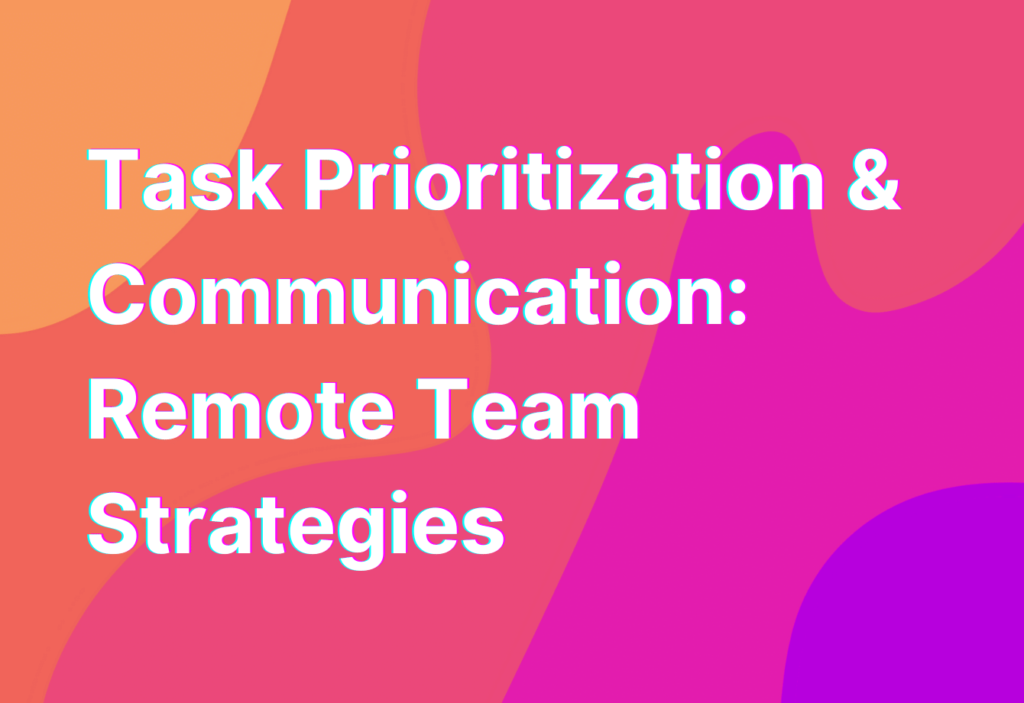Task Prioritization & Communication: Remote Team Strategies
Hey there, remote work warriors! It’s Ashley here, your friendly neighborhood remote work advocate. Today, I want to dive into a topic that is crucial for the success of any remote team: task prioritization and communication. As someone with 10 years of remote work experience in the tech industry, I’ve learned a thing or two about keeping tasks organized and ensuring effective communication. So, grab your favorite cup of coffee and let’s get started!
The Importance of Task Prioritization
When you’re working remotely, it’s easy to get overwhelmed by the sheer number of tasks on your plate. That’s why task prioritization is key. By prioritizing your tasks, you can ensure that you’re focusing on the most important and urgent ones first. This not only helps you stay organized, but it also improves your productivity and reduces stress. So, how can you effectively prioritize your tasks in a remote team setting? Let’s find out!
1. Create a To-Do List
The first step in task prioritization is creating a to-do list. This simple yet powerful tool allows you to see all your tasks at a glance and helps you stay organized. Start by listing down all the tasks you need to complete, and then prioritize them based on their importance and deadlines. You can use a project management tool like Trello or Asana to create and manage your to-do list.
Pro tip: Did you know that using a digital to-do list can increase your productivity by 25%? It’s true! So, ditch the pen and paper and embrace the digital age.
2. Identify Urgent and Important Tasks
Not all tasks are created equal. Some are more urgent and important than others. To effectively prioritize your tasks, identify the ones that require immediate attention and those that have a high impact on your team’s goals. These tasks should be at the top of your to-do list. Remember, it’s all about focusing on what matters most.
Pro tip: The Eisenhower Matrix is a great tool for identifying urgent and important tasks. Give it a try!
3. Communicate with Your Team
Task prioritization is not just an individual effort; it’s a team effort. As a remote team, it’s crucial to have open and transparent communication about task priorities. Regularly check in with your team members to ensure everyone is on the same page. Use collaboration tools like Slack or Microsoft Teams to facilitate communication and keep everyone informed.
Pro tip: Effective communication is the backbone of remote teamwork. If you want to learn more about improving communication in remote teams, check out this User-centered design (UCD) communication guide.
Effective Communication Strategies for Remote Teams
Now that we’ve covered task prioritization, let’s talk about communication strategies for remote teams. Communication is the glue that holds remote teams together, so it’s important to get it right. Here are some strategies to help you improve communication within your remote team:
1. Use Video Conferencing
Video conferencing is a game-changer for remote teams. It allows you to have face-to-face interactions, even if you’re miles apart. Schedule regular video meetings with your team to discuss tasks, brainstorm ideas, and build rapport. Seeing each other’s facial expressions and body language can greatly enhance communication and foster a sense of connection.
2. Embrace Instant Messaging
Instant messaging tools like Slack or Microsoft Teams are a remote worker’s best friend. They enable real-time communication, making it easy to ask quick questions, share updates, and collaborate on projects. Create dedicated channels for different topics or projects to keep conversations organized and easily searchable.
3. Set Clear Expectations
Clear expectations are essential for effective communication in remote teams. Make sure everyone on your team understands their roles, responsibilities, and deadlines. Use project management tools to assign tasks, set deadlines, and track progress. This not only helps keep everyone accountable but also ensures that tasks are completed on time.
Wrapping Up
Task prioritization and communication are the pillars of successful remote teamwork. By prioritizing your tasks and communicating effectively with your team, you can ensure that everyone is on the same page and working towards a common goal. Remember, remote work may have its challenges, but with the right strategies in place, you can conquer anything that comes your way.
So, go forth and prioritize those tasks like a pro! And if you ever need a little pick-me-up, just remember that even the most experienced remote workers make typos (intentionally, of course) and crack a joke or two along the way. Happy remote working!


